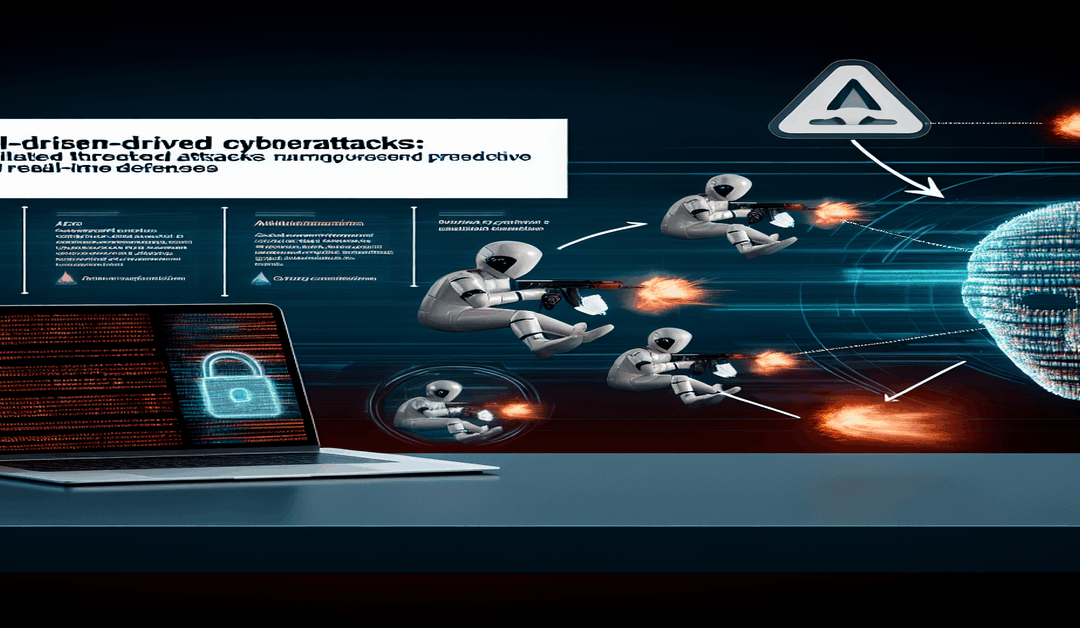The Rise of AI-Driven Cyberattacks: Accelerated Threats Demand Predictive and Real-Time Defenses
In the ever-evolving landscape of cybersecurity, a new breed of threats has emerged, leaving organizations vulnerable and scrambling for advanced defensive strategies. The rise of AI-driven cyberattacks has ushered in an era of accelerated and increasingly complex threats that demand predictive and real-time defenses.
The AI Arms Race: Cybercriminals Embrace Automation and Personalization
As AI technology continues to advance at an unprecedented pace, cybercriminals have been quick to harness its power for nefarious purposes. AI-driven cyberattacks have become more accessible and cost-effective, allowing attackers to automate and personalize their malicious campaigns with minimal technical expertise. This democratization of cybercrime has led to a surge in sophisticated attacks that can evade traditional security measures.
One of the most alarming trends in AI-driven cyberattacks is the rise of AI-generated malware. By leveraging machine learning algorithms, attackers can create malware that adapts and evolves to bypass detection systems. These intelligent malware strains can analyze network vulnerabilities, identify high-value targets, and even modify their behavior to blend in with legitimate traffic.
Ransomware and Double Extortion: A Lucrative Threat
Ransomware attacks have long been a thorn in the side of organizations, but the integration of AI has taken this threat to new heights. Cybercriminals are now employing AI to automate and optimize their ransomware campaigns, maximizing their chances of success and profitability.
Moreover, the rise of double extortion tactics has made ransomware attacks even more devastating. In addition to encrypting an organization’s data, attackers now steal sensitive information and threaten to sell it on the dark web unless an additional payment is made. This tactic puts immense pressure on victims, as the potential reputational damage and legal consequences of data exposure can be catastrophic.
The Art of Deception: AI-Powered Social Engineering
Social engineering has always been a potent weapon in the cybercriminal’s arsenal, but AI has taken it to a new level of sophistication. With the help of natural language processing and machine learning, AI tools can now convincingly replicate communication styles, making it easier for attackers to manipulate and deceive their targets.
These AI-powered social engineering attacks can be highly targeted and personalized, exploiting individuals’ trust and vulnerabilities. From crafting convincing phishing emails to generating deepfake videos, AI has made social engineering more effective and harder to detect. The ability to scale these attacks across languages and geographies further amplifies the threat.
The Looming Threat of Multi-Agent AI Attacks
As if the current landscape of AI-driven cyberattacks wasn’t daunting enough, there is growing concern about the potential for multi-agent AI attacks. In this scenario, multiple AI systems collaborate and coordinate their efforts to conduct faster and more efficient cyberattacks.
The idea of AI systems working together to exploit vulnerabilities, adapt to defenses, and maximize the impact of their attacks is a chilling prospect. Multi-agent AI attacks could overwhelm even the most robust security measures, leaving organizations struggling to keep pace with the ever-evolving threat landscape.
The Call for Advanced Defenses: Predictive and Real-Time Protection
In the face of these accelerated and complex threats, traditional cybersecurity approaches are no longer sufficient. Organizations must adopt advanced, real-time, and predictive cybersecurity measures to stay ahead of the curve.
One promising approach is to fight fire with fire by leveraging AI for defensive purposes. AI-powered cybersecurity systems can analyze vast amounts of data in real-time, identifying anomalies and potential threats that human analysts might miss. These systems can learn and adapt to new attack patterns, providing a proactive and dynamic defense against AI-driven cyberattacks.
However, relying solely on AI for cybersecurity is not a silver bullet. Organizations must also invest in a holistic approach that includes regular security audits, employee training, and incident response planning. Collaboration and information sharing among industry partners can also help strengthen collective defenses against AI-driven threats.
The Future of Cybersecurity: Embracing AI and Staying Vigilant
As we navigate this new era of AI-driven cyberattacks, it is crucial for organizations to remain vigilant and proactive. The threat landscape will continue to evolve, and staying ahead of the curve will require a commitment to continuous learning and innovation.
Embracing AI as a defensive tool, while also being aware of its potential misuse by attackers, is a delicate balance that cybersecurity professionals must strike. By investing in advanced technologies, fostering a culture of security awareness, and collaborating with industry partners, organizations can build resilience against the rising tide of AI-driven cyberattacks.
The future of cybersecurity lies in our ability to adapt and evolve alongside the threats we face. By harnessing the power of AI for good and staying one step ahead of cybercriminals, we can protect our digital assets, safeguard our privacy, and ensure a more secure future for all.
#CyberSecurity #ArtificialIntelligence #CyberAttacks #AIDefense #CyberResilience
-> Original article and inspiration provided by MixMode Threat Research
-> Connect with one of our AI Strategists today at ReviewAgent.ai

